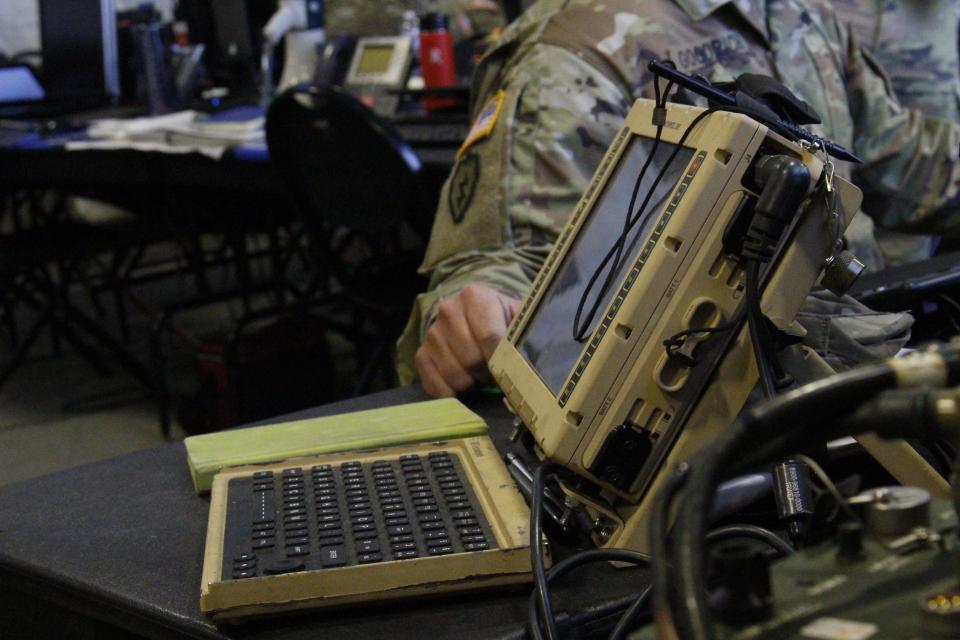Fort Stewart's 3rd Infantry Division at the forefront of U.S. Army warfighting strategy
At the Fort Stewart Mission Training Complex, a cluster of beige canvas tents belies the technological hub that lies within. For the next few days, the base’s division-main tent is home to a flurry of computers, monitors, wires and maps — tools used to calculate, mark and, ultimately, aid the U.S. Army’s effort to create new warfighting doctrine or strategy to be used in future large-scale combat.
The Army is constantly having to remain relevant and adapt, said Col. Ryan McCormack, 3rd Infantry Division’s chief of staff. They’re always asking, “How do we train our people to use new equipment and strategies?”
Military news: U.S. Army officials identify Fort Stewart soldier killed in helicopter crash
On Monday morning, Fort Stewart Army officials gave media an inside look at those operations at a time when the U.S. Army and NATO allies are on high alert due to Russian's military invasion of Ukraine, a country that borders two NATO-member nations.

Broader changes to the U.S. Army Defense Strategy have led up to this effort, said McCormack. The Army has been preparing for more large-scale operations for years such as the current Russia-Ukraine conflict, and are, therefore, adjusting warfighting processes to accommodate those possibilities.
'Go right now': For Fort Stewart spouses, Ukraine-related deployment came suddenly
At the forefront of that future warfighting doctrine is Fort Stewart's 3rd Infantry Division. The 3rd ID has been called on to vet these new strategies because of its experience in warfighting and its position “to become the most modern division in the U.S. Army” according to Fort Stewart officials.

Primed for this opportunity, the division will test through simulation and provide feedback on warfighting concepts that could be used by the U.S. Army and NATO allies for future large-scale operations.
“We have people who are looking at the future — five, 10, 15, 20 years (from now) — saying, ‘based on these technologies, based on the way economics and the world is going, we expect this type of adversary to pop up,’” explained Lt. Col. Billy VanCuren of the U.S. Army’s Joint Modernization Command.

“When we look at concepts, we have to take into account things that either don't exist right now, or our projection for how things will change either based on a technology or even government structures,” said VanCuren.
Based on those predictions, the Army’s Joint Modernization Command comes up with the best strategies that must be tested by a unit such as the 3rd ID.
More: Second round of Fort Stewart troops disembark from Savannah, reinforce NATO allies
“It’s critical that actual soldiers who do these things on a daily basis give their input,” said VanCuren, “We will take that back and make some modifications and come back to either this unit or another one with those changes.”
The Joint Modernization Command is part of the broader U.S. Army Futures Command, which oversees the modernization of the Army in its entirety. The command regularly runs experiments to test new capabilities, but their run at Fort Stewart is part of a much larger operation.
Along with the 3rd ID, troops from other divisions have come together for this assessment. The III Armored Corps and 1st Cavalry Division from Texas’s Fort Hood as well as California’s 40th Infantry Division are providing their input.
“We brought them together for this particular event,” said VanCuren, “a joint warfighting assessment is one of the largest army modernization efforts.”
'Very hectic': US troops from Fort Stewart rushed to Europe on plane from Hunter Army Airfield
Once the assessment is complete, the Joint Modernization Command will pass along reports to higher Army headquarters for evaluation.
Nancy Guan is the general assignment reporter covering Chatham County municipalities. Reach her at nguan@gannett.com or on Twitter @nancyguann.
This article originally appeared on Savannah Morning News: Fort Stewart soldiers aid U.S. Army in testing new warfighting strategy

